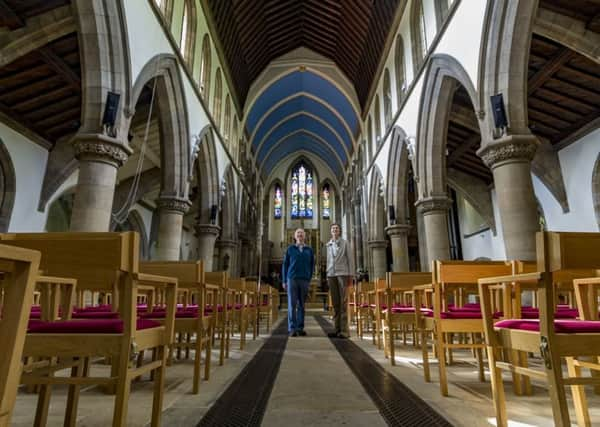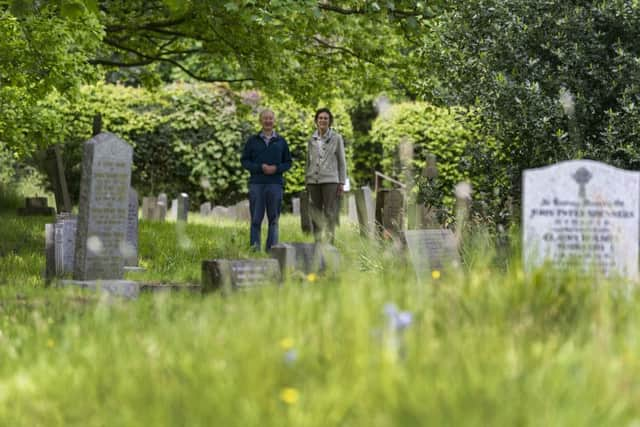The project hoping to bring Yorkshire's cemeteries back to life


Red-winged angels hover, Adam and Eve clasp hands, and around them are zebra, deer, camels, lions, flamingos, crocodiles, swans, a whole Old Testament zoo of animals and birds. Dr Suzanne Dalton and Dr Mike Willison, from the St Chad’s Green Team, point out detail after detail and then we step outside the church, in the Leeds suburb of Far Headingley, to explore a more tangible, less exotic Garden of Eden. It has bees and butterflies in place of camels and crocodiles and is an apt place to mark Cherishing Churchyards Week.
The week, which starts today, celebrates churchyards and burial grounds and aims to raise awareness of the treasures they often contain. At its centre is Caring for God’s Acre, a national charity championing churchyard conservation.
Advertisement
Hide AdAdvertisement
Hide AdEngland and Wales have more than 20,000 churchyards and burial grounds – places to find nature, local history and peace and tranquillity. And, as the Shropshire-based charity points out, many of them have remained virtually untouched for generations, allowing plants to grow and wildlife to flourish.


The aim is to conserve them as havens of nature and make imaginative use of them... ideas that can have no more boundlessly enthusiastic advocate than Suzanne Dalton.
“This churchyard is an oasis in suburbia,” she says as we stride over the grass. “You’ve got space, you can sit and listen to the birds and watch the butterflies. Whatever time of year you come, there’s something to enjoy... look at those ox-eye daisies over there and that lady’s smock... oh, I’ve got so much to show you!”
Suzanne is project leader of the Green Team, winner of the Community award in last year’s Yorkshire Post Environment Awards. The nine-strong team aims, she says, “to look after the churchyard for wildlife as well as the burial of ashes and people... it can be quite a delicate balance.”
Advertisement
Hide AdAdvertisement
Hide AdWith an estimated 98 per cent of Britain’s ancient and unspoiled grasslands vanishing since 1945, this and similar projects across the country have been set up to make the most of churchyards’ rich diversity. One way is to create “mini nature reserves” or “living sanctuaries” of bird and insect-friendly plants.


At the most basic level, it can come down to the length of the grass. Longer grass is more ecologically beneficial than manicured lawns, so St Chad’s grass is mown to different heights, with some left unmown until late July. Not everyone, however, is impressed.
“Some people want it to be like a bowling green,” says Mike. “On and off over the years, we’ve had people say: ‘This churchyard’s a mess; what are you going to do about it?’ You’ve got to compromise between not having a blade of grass out of place and letting it run riot.” The Green Team aren’t doctrinaire, though. As Suzanne says: “If people feel strongly about it, we don’t mind them cutting the grass around family graves.”
The aim is to create a viable ecosystem, with oak trees, for example. They create a food chain all of their own: insects eat their leaves, birds feed on the insects, and passing sparrowhawks prey on the smaller birds.
Advertisement
Hide AdAdvertisement
Hide AdWe stop in front of one such oak, a sturdy survivor with a 6ft wide trunk. It’s thought to date back to Elizabethan days and may have been a sapling when the Spanish Armada set sail. High-spired St Chad’s Church – “proud and prosperous” the architectural historian Nikolaus Pevsner called it – is a new arrival by comparison.
With its light, airy interior and sky-blue chancel ceiling studded with golden stars, it was built in 1868 on the ancient hay meadows and grazing land of now-demolished Ivy House Farm. Chemical fertilisers, herbicides and insecticides have never been used on this land – between a bluebell wood and the busy Otley Road – giving it great potential for wildlife.
Until the Green Team was formed, however, the grass in the sizeable graveyard was close-mown. “The plants were there but they weren’t given half a chance, no, a quarter of a chance,” says Suzanne, as we pass clusters of bat boxes and widely spaced bird boxes.
Some 45 species of birds have been spotted here, including red kites, tawny owls, buzzards, hobbies and treecreepers, along with 13 species of butterflies (“There goes an orange-tip”) and 42 species of wildflowers. Hedges aren’t cut when birds are nesting, and there’s only one major clearance a year.
Advertisement
Hide AdAdvertisement
Hide AdThe impetus for setting up the group came 15 years ago when Suzanne attended a workshop by the Yorkshire Living Churchyard Project, a joint venture between the Yorkshire Wildlife Trust and Yorkshire Dioceses. The workshop focused on conservation work in another churchyard. “I thought: ‘We could do this at St Chad’s,’” says Suzanne and glances down. “Look, there’s a bumblebee down there; they like making nests in old mouse holes and vole holes.”
With great delight, she points out a gravestone where tiny fossilised oyster shells are preserved and another where hundreds of ladybirds were once discovered hibernating in the deep-cut lettering.
We move on to the “nectar supermarket” where, over the growing season, different flowers provide continuous nectar and pollen. Then the “insect hotel”, which looks like an artwork filled with stone and cones but is in fact a refuge for smaller creatures, including mice and snails.
And there are the graves of Sir Nathan Bodington, first Vice-Chancellor of Leeds University, and Alderman Alf Cooke, a Victorian pioneer of colour printing who became “Her Majesty’s Colour Printer”.
Advertisement
Hide AdAdvertisement
Hide Ad“We want to maintain the connection with nature that’s gradually been destroyed in modern life,” says Suzanne. “Children start off being fascinated by insects and animals, and then all too often they get involved with iPads and computers... look at these vetches down here, and that speedwell and the forget-me-nots... and that’s fox poo.”
A fortnight on from Cherishing Churchyards Week, Caring for God’s Acre will be staging a conference on the Beautiful Burial Ground at Heslington church, near York, on June 29. And the name? It comes from a line by the poet Longfellow: “I love that ancient Saxon phrase, which calls the burial ground God’s Acre,” adds Suzanne.
The charity points out that “in the hurly burly of the modern world, it’s often difficult to find somewhere to sit and think”. Not at St Chad’s.
I sit in the churchyard’s Garden of Rest and eat my lunchtime sandwich. There’s a perfect stillness here; the only sound is birdsong. In the midst of death, we are in life.
Advertisement
Hide AdAdvertisement
Hide AdSt Chad’s is marking Cherishing Churchyards Week on Sunday, June 12, with a Pet Service (9.30am) and a Community Tea Party to celebrate the Queen’s 90th official birthday. For further information on Cherishing Churchyards Week go to caringforgodsacre.org.uk.